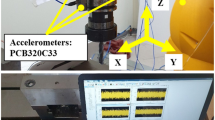Abstract
The modelling and control of the grinding force for the robotic disc-grinding process are described. Modelling experiments were conducted using an industrial robot equipped with a pneumatic grinder and a force sensor. The models relating the commanded depth of cut to the corresponding normal grinding force was developed based on nine sets of experimental data. These data were collected at three different grinding paths with three different pseudo-random binary sequence amplitudes in order to fully investigate the dynamics of the process. Using the extended-least squares method for recursive parameter estimation, a linear fourth-order autoregressive moving average with exogenous variable model was successfully developed for the robotic disc-grinding process.
Using the identified models, an adaptive pole placement controller was developed and tested using computer simulations, The purpose of the controller is to regulate the normal grinding force. The results demonstrate effective control under various grinding conditions.
Similar content being viewed by others
References
R. K. Miller,Industrial Robot Handbook, Van Nostrand Reinhold, New York, p. 198, 1989.
R. T. Kurfess, D. E. Whitney and M. L. Brown, ‘Verification of dynamic grinding model’,Journal of Dynamic System, Measurement and Control,100, pp. 403–409, 1988.
B. J. Ulrich, A. K. Srivastava and M. A. Elbestawi, ‘Analysis of the robotic disk grinding process’,Journal of Advanced Manufacturing Technology,7, pp. 82–92, 1992.
M. W. Spong and M. Vidyasagar,Robot Dynamics and Control, Wiley, New York, 1989.
A. R. Tate, ‘Closed loop force control for a robotic grinding system’, MS thesis, MIT, Cambridge, Mass., 1986.
L. Liu, B. J. Ulrich and M. A. Elbestawi, ‘Robotic grinding force regulation: design, implementation and benefits’, Proceedings, IEEE International Conference on Robotics and Automation, Cincinnati, Ohio, pp. 258–265, 1990.
D. E. Whitney, A. C. Edsall, A. B. Todtendopf, T. R. Kurfess and A. R. Tate, ‘Development and control of an automated robotic weld bead grinding system’,Journal of Dynamic System, Measurement and Control,112, pp. 166–176, 1990.
H. Dai, A. K. Srivastava, M. A. Elbestawi and N. K. Sinha, ‘Modeling of the PUMA robot for control of grinding applications’, Proceedings of 9th IFAC/IFORS Symposium on Identification and System Parameter Estimation,2, pp. 1062–1067, Budapest, 1991.
N. K. Sinha and Y. Zhou, ‘Estimation of model order using singular value decomposition’, Proceedings of 21st Annual Conference on Information Science and Systems, pp. 532–536, 1987, Baltimore, Maryland.
N. K. Sinha and B. Kuszta,Modeling and Identification of Dynamic Systems, Van Nostrand Reinhold, New York, 1983.
L. Ljung, T. Soderstrom,Theory and Practice of Recursive Identification. MIT Press, Cambridge. Mass., 1983.
K. J. Astrom and B. Wittenmark,Adaptive Control, Addison-Wesley. Reading, Mass., 1990.
Author information
Authors and Affiliations
Rights and permissions
About this article
Cite this article
Dai, H., Yuen, K.M. & Elbestawi, M.A. Parametric modelling and control of the robotic grinding process. Int J Adv Manuf Technol 8, 182–192 (1993). https://doi.org/10.1007/BF01749909
Accepted:
Issue Date:
DOI: https://doi.org/10.1007/BF01749909




